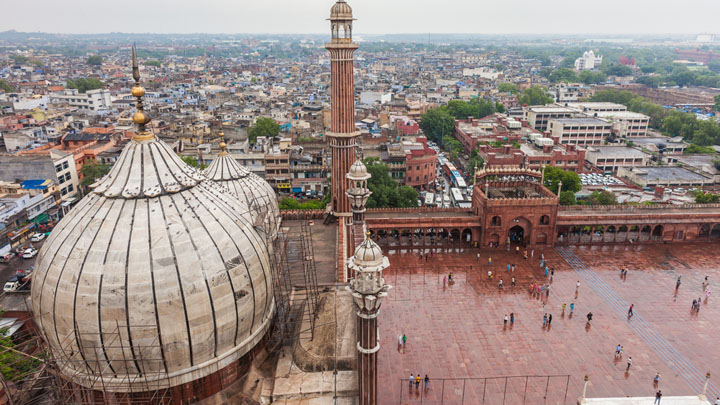Indian summer: New Delhi

When I first went to India back in 1974 I was told ‘You’ll either love it or loathe it”. I loved it! You’re either fascinated by the bustling, jostling, jiving cacophony of noise, smell and colour or you’re appalled and intimidated by it.
Last time I was here back in 1995 were were filming for the Wildlife program. We filmed cobras and Langur monkeys in Jodhpur and got up close and personal with the rats at the infamous rat temple in Bikaneer. This time it’s different: we’re on holidays. Together with close friends Phil and Josyl, Cecile and I are spending three weeks in Northern India before heading down to Mumbai and back to Bangkok.
First stop is New Delhi. It’s busier, more congested and dirtier than I remember but it’s lost none of its appeal. From the luxury of the sprawling mansions and embassies in the green belt of New Delhi to the rubbish strewn alleyways of Old Delhi, it’s a city of contrast. But then again that’s India. There are more millionaires than the entire population of Australia, but the overall poverty is grinding. At times sad but mostly uplifting, colour and humour somehow manage to triumph over depression and despair.
But then there’s the history. And there’s no lack of that in Delhi. We’re staying on the outskirts of Old Delhi, near the famous 17th century Red Fort which is our first port of call. There’s bureaucracy a plenty in India but often it’s not accompanied by logic. Where our driver drops us off is nowhere near the entrance. It’s not his fault, those are the rules. There’s an entrance to the Fort 50 yards from the car park but you can’t use it. Instead you wind your way round the walls for close to a kilometre, before finally entering at Lahore gate. Mind you it’s a pleasant walk. The rustic red of the Fort’s walls seem to shimmer in the early morning fog. (Actually it’s pollution but fog sounds more romantic.)
There’s a lot to see at the Red Fort so allow yourself at least two hours. Shah Jahan built the Fort back in 1638 but never actually took up full residence because his disloyal son had him imprisoned at Agra Fort. No sign of filial devotion there. The last Mughal Emperor of Delhi was flushed from the Fort by the British in 1857 and then exiled to Burma for his role in the first War of Independence. The British then turned into a barracks. Naturally.
In the afternoon we visited the 12th Century Qutab Minar, the hand carved 234 ft monument that has withstood the ravages of time for over 1500 years. Its iron pillar hasn’t even rusted.
If you’re into mosques, they don’t come much more impressive than Jama Masjid. It’s the largest in India and the final architectural extravagance of Shah Jahan, with a courtyard capable of holding 25,000 devotees. Unlike mosques in other parts of the world they actually charge foreigners to enter. It’s 300 rupees which is about 7 dollars. This entitles you to climb the tower and I’m proud to say that the oldest member of our party (me) was the only one to take advantage of this. The climb took it’s toll but the view at the top was almost worth it. To one side the Red Fort and the pinnacles of ancient Hindu temples, on the other the sprawling heaving mass of Old Delhi.
Getting to the top of the tower had been hard work but staying at the top without plunging back down the stairs was even more challenging. A narrow ledge circled the top of the stairs and on the ledge were perched a group of selfie taking young people, the girls resplendent in multicoloured saris and red dotted foreheads and the boys strutting their supposed masculinity with the self belief of the Indian adolescent male. To say they were surprised to see me was an understatement. The older generation didn’t even attempt the climb let alone a hard drinking chain smoking former journo, whose prime was decades earlier and even back then had an exercise routine that consisted largely of a fifteen minute stroll to the pub. Somewhat reluctantly they gave me some space and I tried to remain balanced and not tumble back down the winding steps, an action that would have resulted in certain injury and considerable pain. I looked back over Old Delhi. Hawks and vultures circled the meat markets, diving down to dispose of the dumped scraps and offal in an adjoining walled enclosure. Nothing is wasted and hawks and the army of street dogs alike are the beneficiaries. Street dogs are everywhere in Delhi. They’re tolerated and occasionally fed but they’re not pets. Each group has its own turf and interlopers are not tolerated. I watched the canine law of the streets in action every morning outside our hotel. It was fascinating and the body language unmistakeable. A sub adult male ” visitor” cowered in fear as he was surround by the pack. After five or six minutes he was eventually allowed to retreat, tail low between his legs, glancing backwards at the group that ruled that corner.
The food of course is magnificent, One night we decide to eat at a restaurant renowned throughout India. It’s called Karim’s and is renowned for it’s mutton curries and kebabs. Just inside Old Delhi, it turns out to be not one but three restaurants inside a small cul de sac. No silver service or porcelain here, just fire breathing tikka bearing clay pots and the most unbelievable smells rising from smoke belching open kitchens. Service is fast, furious and efficient. The food? Well it if we have better during our three weeks here I’ll be astonished.
It’s six o’clock in the evening and I’m strolling the alleyways of Old Delhi. Actually strolling doesn’t really cut it. What I’m actually doing is dodging motor scooters and rickshaws that share the space with the heaving populace of vibrant sari clad beauties, hijab wearing Moslem women whose eyes glint mysteriously from behind the veils, scampering children, goats and street dogs. The noise is all empowering. Beeping scooters,distorted Hindu music and the constant chanting from the nearby mosque combine to envelope the senses, including of course your eardrums. From clothing to hubcaps, dosas to charcoal, you can buy anything in these winding alleyways. I love it!
I’ve now discovered what the Moslem women of Old Delhi do when the men go to the mosque. They go shopping. And they’re not buying hijabs or burqas, they’re buying colourful scarfs, dresses and underwear, presumably only to be worn in the sanctity of their homes. Here in Old Delhi there appears to be complete religious tolerance. Hindus and Moslems walk , talk and laugh together. In other parts of India there is occasional tension but in these alleyways it appears non-existent.
Turning the corner, I spot a light half way down one of the few dark alleys in residential Old Delhi. I decide to investigate. A group of Moslem men are gathered round the doorway peering into a small, lantern lit room. A tall man is addressing them. Beside him is a magnificent ram, horns thick and curving backwards and looping under and then over its ears. He somehow looks contemptious of the crowd around him. He knows he’s a star and he knows his fate is not in doubt. It will be many years before his offal remains feed the hawks and vultures surrounding the abattoirs. This is an auction and he’s the prize. I stroll back down the alley. It was a nice way to end the evening. For one creature at least in this human and animal crockpot, life was looking good.
We’re going to Kalka and then Shimla tomorrow. The journey to Kalka is a four hour train ride and then another four hours by car to Shimla. It’s been a few years since my last Indian train trip. I’m looking forward to it. I think.
Tell us, have you ever been to India?
To write for Starts at 60 and potentially win a $20 voucher, send your articles to our Community Editor here.









 Proudly Australian owned and operated
Proudly Australian owned and operated